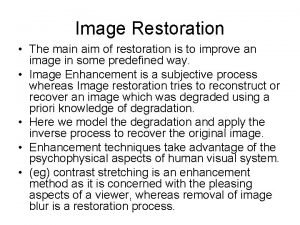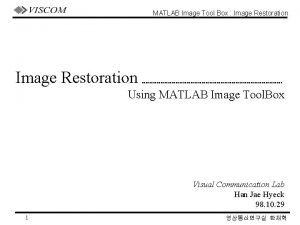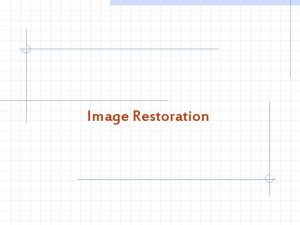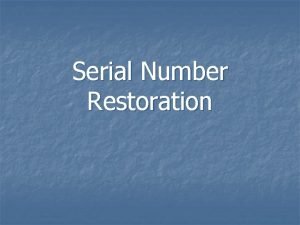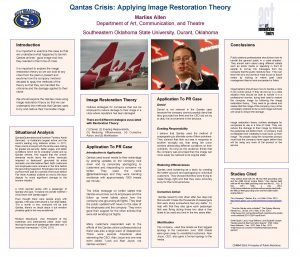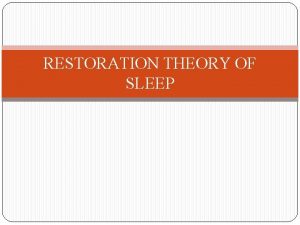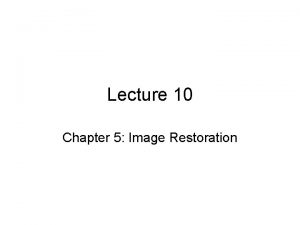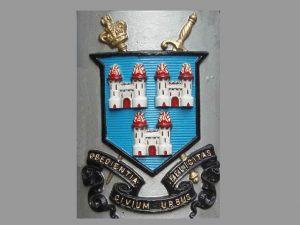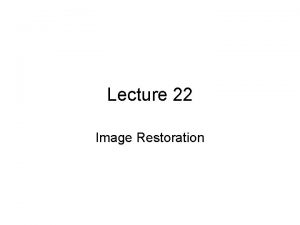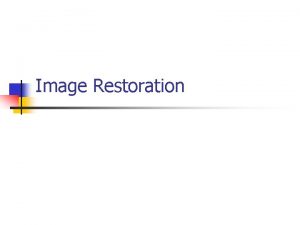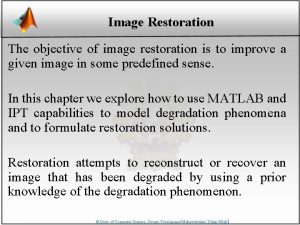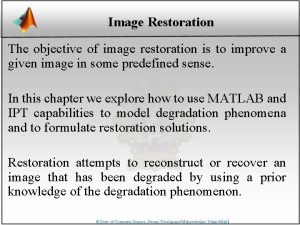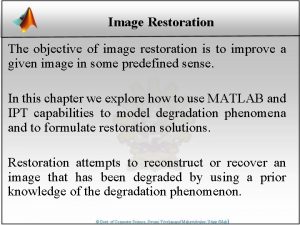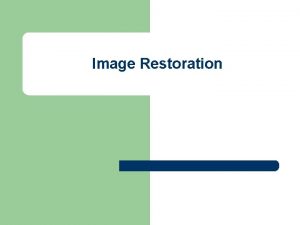Image Restoration 1 Image Restoration As in image











- Slides: 11

Image Restoration 1

Image Restoration As in image enhancement, the ultimate goal of restoration techniques is to improve an image in some predefined sense. Although there areas of overlap, image enhancement is largely a subjective process, while image restoration is for the most part an objective process. Restoration attempts to reconstruct or recover an image that has been degraded by using a priori knowledge of the degradation phenomenon. Thus restoration techniques are oriented toward modeling the degradation and applying the inverse process in order to recover the original image. 2

Image Restoration By contrast, enhancement techniques basically are heuristic procedures designed to manipulate an image in order to take advantage of the psychophysical aspects of the human visual system. For example, contrast stretching is considered an enhancement technique because it is based primarily on the pleasing aspects it might present to the viewer, whereas removal of image blur by applying a deblurring function is considered a restoration technique. 3

Image Restoration Some restoration techniques are best formulated in the spatial domain, while others are better suited for the frequency domain. For example, spatial processing is applicable when the only degradation is additive noise. On the other hand, degradations such as image blur are difficult to approach in the spatial domain using small masks. In this case, frequency domain filters based on various criteria of optimality are the approaches of choice. These filters also take into account the presence of noise. 4

A Model of the Image Degradation/Restoration Process Figure. (a) shows, the degradation process is modeled in this figure as a degradation function that, together with an additive noise term, operates on an input image f(x, y) to produce a degraded image g(x, y). Given g(x, y), some knowledge about the degradation function H, and some knowledge about the additive noise term the objective of restoration is to obtain an estimate of the original image. 5

A Model of the Image Degradation/Restoration Process We want the estimate to be as close as possible to the original input image and, in general, the more we know about The degraded image is given in the spatial domain by 6

A Model of the Image Degradation/Restoration Process where h(x, y) is the spatial representation of the degradation function and the symbol "*" indicates convolution. We know that convolution in the spatial domain is equal to multiplication in the frequency domain, so we may write the model in an equivalent frequency domain representation as : where the terms in capital letters are the Fourier transforms of the corresponding terms in previous equation. 7

Model for Image Degradation/Restoration Figure (a) : Model for Image Degradation/Restoration 8

Causes of Noise o The principal sources of noise in digital images arise during image acquisition (digitization) and/or transmission. o The performance of imaging sensors is affected by a variety of factors, such as environmental conditions during image acquisition, and by the quality of the sensing elements themselves. o For instance, in acquiring images with a CCD camera, light levels and sensor temperature arc major factors affecting the amount of noise in the resulting image. 9

Causes of Noise o Images are corrupted during transmission principally due to interference in the channel used for transmission. o For example, an image transmitted using a wireless network might be corrupted as a result of lightning or other atmospheric disturbance. 10

Spatial and Frequency Properties of Noise o Frequency properties refer to the frequency content of noise in the Fourier sense. For example, when the Fourier spectrum of noise is constant, the noise usually is called white noise. o We assume that noise is independent of spatial coordinates, and that it is uncorrelated with respect to the image itself (that is, there is no correlation between pixel values and the values of noise components). 11
 Image restoration is to improve the dash of the image
Image restoration is to improve the dash of the image Noise
Noise What is image restoration in digital image processing
What is image restoration in digital image processing Image restoration matlab
Image restoration matlab Image restoration adalah
Image restoration adalah Serial number restoration process
Serial number restoration process Image restoration theory
Image restoration theory Restoration theory of sleep
Restoration theory of sleep Image sharpening in digital image processing
Image sharpening in digital image processing Image restoration theory
Image restoration theory Martello tower restoration man
Martello tower restoration man Disaster restoration buchanan county
Disaster restoration buchanan county
